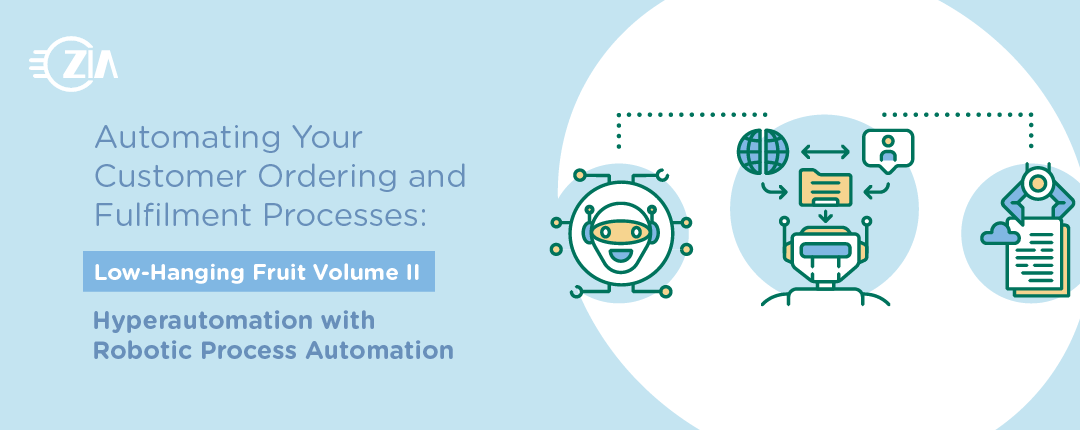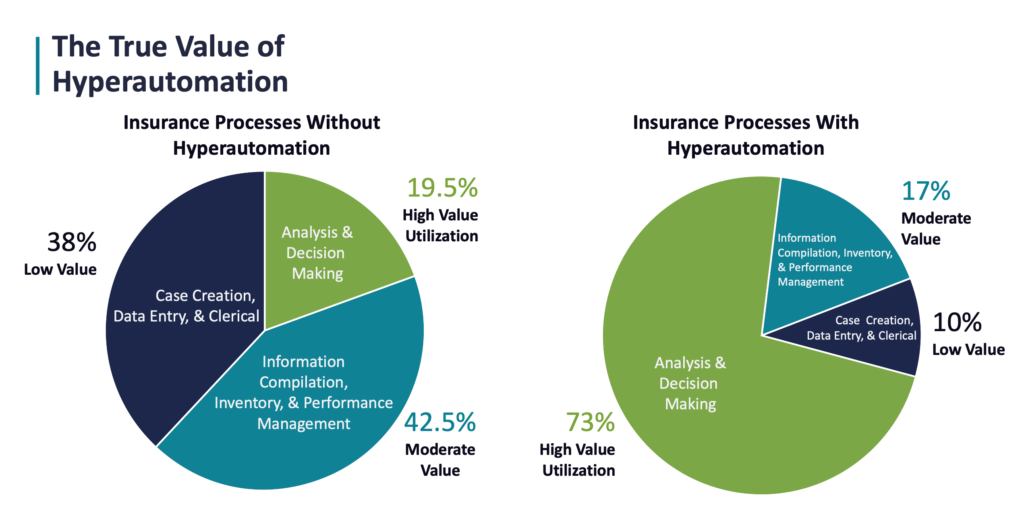In my last blog of this series, Automating Your Customer Ordering and Fulfillment Process: Low-Hanging Fruit Volume I, I focused on Digitizing Core Organizational Processes by leveraging Intelligent Document Capture solutions to remove paper processes from your business. I initially planned for the next blog in the series to address strategies around no-code/low-code workflows and automating compliance and governance. Instead, I decided that addressing the use of Robotic Process Automation (RPA) to accelerate hyperautomation/digital transformation was a bigger priority. Keep an eye out for more information on no-code/low-code in volume III.
Zia Consulting deploys RPA for our clients, at any stage of their hyperautomation journey. RPA helps customers realize a quick win, remove process pain points, and demonstrate a clear return on investment for their business. RPA is a gateway drug for hyperautomation. Recently, I hosted a webinar on the ways to automate the order to service delivery/provisioning process for Technology Service Providers and Distributers (i.e., Telecom, Cloud, Internet, and MSP providers). During this webinar, I speak specifically to RPA, but I wanted to cover it in more detail in this blog.
Zia has been helping companies hyperautomate (previously called Digital Transformation) for nearly two decades. During that time, Zia identified six key components to hyperautomation. Deploying RPA falls under two of the key components: Automated Business Processes and New Technology.
Before I dive deeper, let’s recap what hyperautomation is and why it is important for your business.
Hyperautomation is:
- A business-driven, disciplined approach that organizations use to rapidly identity, vet, and automate business and IT processes.
- Useful to companies that are increasingly pushed to perform better and faster with fewer people and less money.
- Refers to the application of advanced technologies to automate processes that would typically be performed by humans.
Why is Hyperautomation important? It can be very hard for companies to succeed when faced with high inflation, the great resignation, fear, instability, and competition. The great resignation is here. There are 1.9 jobs per employee right now. According to a recent Gallup poll, “State of the Global Workplace Gallup Report, only 31% of employees in the USA and Canada are actively engaged at work (i.e., Psychological owners that drive performance and innovation); 53% of employees are not engaged (i.e., unattached, no energy or passion); and 17% of your employees are actively disengaged (i.e., resentful, unhappy and undermining engaged employees). Hyperautomation helps companies become disruptive in their prospective market, have happier employees, produce better margins, engage more customers, and have less risk. Companies that hyperautomate have employees that spend the majority of their time on analysis and decision making. Companies without hyperautomation see their employees spend the majority of their time on case creation, data entry, clerical tasks, information compilation, inventory, and performance management. Only a very small percentage spend quality time on analysis and decision making.
A recent Gartner report, Top Strategic Technology Trends for 2022, produced the following statistics:
- 50% of CEOs and 69% of board of directors demand accelerated growth and operational excellence.
- 80% of organizations consistently self-report increased or continued investment in hyperautomation initiatives.
- 56% of organizations are estimated to have an average of four or more concurrent hyperautomation initiatives underway, and leading companies have over 10.
Why does RPA facilitate hyperautomation? Many companies have failed at attempts to automate, or just do not know where to start. RPA can be quickly and inexpensively deployed at any stage of a company’s business to mitigate manual processes and bottlenecks. A successful RPA implementation frees employees for higher value activities, allows companies to be more elastic or scalable, increases customer satisfaction, and realizes higher margins. Our experience shows that an initial win with RPA helps to create a positive culture of automation, as companies quickly become addicted to the success and identify additional use cases in their business to automate. Additionally, RPA technology is easily learned and managed by our customers, and does not require ongoing expensive third party engagements. The same Gartner report cited above found that 80% of executives expect to increase spending on digital business initiatives, 65% plan to increase the pace of digital business initiatives, and 72% will shorten timelines for implementing digital business initiatives. Zia is seeing this trend with our clients as well. The ability to deploy RPA initiatives both quickly and often is attractive to executives looking to meet the demands of their leadership.
Zia Consulting is a software reseller, systems integrator, and consulting company that leverages best-of-breed technologies to solve hard problems. RPA is one of the technologies we deploy for our clients to strategically solve problems on time and within budget. Zia Consulting partners with Hyland and Uipath for our RPA solutions.
The next section of this blog covers Zia Consulting’s RPA solution, the kinds of processes that can be automated with RPA, the types of processes that are not a good candidate for RPA, and several examples of how RPA can be used in your customer ordering and fulfilment process.
Zia Consulting RPA Solution
According to Hyland, RPA automates manual, rule-based, high volume, and repetitive tasks where human touch does not add business value. RPA enables users to quickly, accurately, and intuitively analyze processes down to the click level and automatically document process steps. Users leverage low-code, drag and drop tools to quickly and easily build bots, and create brand-new automations. The technology is designed to be deployed and configured without extensive customization. With user-focused features, business groups are able to easily deploy new bots as business needs evolve. This frees up IT departments to focus on more demanding initiatives. Our solutions efficiently run unattended or attended automations ensuring maximum bot utilization and scalability, while allowing users to manage and orchestrate bots with ease using a real-time intuitive dashboard.
Here a some examples of processes that can be automated with RPA:
- Open email attachments
- Login web or other applications
- Copy and paste data
- Fill in forms
- Execute if/then decisions
- Collect data from the internet
- Connect to existing interfaces (API)
- Perform calculations
- Filter structured data from documents
- Gather social media statistics
Examples of processes that are not good candidates for automation with RPA:
- Unstructured data
- Low volume activity
- No definable business rules
- Already automated/integrated line of business applications
Potential Use Cases
Finance and Accounting
- Accounts Payable (AP) – PO and invoice processing • Sales order management
- Order-to-cash
- Procure-to-pay
- Record to report
- Collections
- Incentive claims
HR
- Payroll
- Benefits administration
- HR records processing
- Employee onboarding
- Stock administration
- Time and attendance management
- Vendor management
IT Department
- Email-related tasks including processing and distribution • File and folder management (synchronizing, deleting, etc.) • Server and application modeling
- Batch processing
- FTP download, upload, backup
- Installations
- Ticket management
Financial Services
- Compliance reporting
- Customer onboarding
- Know Your Customer (KYC) and Anti-money-laundering (AML) • Loan processing
- Account closure
Insurance
- New Business & Underwriting
- Claims processing
- Regulatory compliance
- Policy cancellation
Healthcare
- Reporting for Release of Information requests
- Patient billing
- Claims processing
- File digitization
- Inventory management
- Appointment and procedure scheduling
- Discharge instructions and post-op reminders
Supply Chain
- Inventory management
- Order scheduling and shipment tracking
- Quote, contracts & invoice management
- Work order management
- Returns processing
- Freight management
Hyland RPA can be applied across multiple industries and departments. As you can see from the possibilities shared above, the customer order to fulfillment process is ripe to benefit from RPA technology. I currently work with a client that receives a high volume of emails containing medical records that are gathered from providers and distributed to their clients. Zia designed a solution that will open those emails and take various actions, such as: task assignments, creating new file folders in downstream applications, and logging into medical provider web portals to download and file records. Another benefit to using RPA in a solution like this is that our encrypted bots mitigate potential compliance issues since a human is not handling HIPAA data.
A slam dunk opportunity is for companies to use RPA in the customer ordering process. They can receive structured digital order forms, or scrape order information using Intelligent Document Capture, and then manually enter the data into any other system, including: inventory management, shipping, contract management, work order management, or dispatch to name a few. This process can be completely automated with an inexpensive and easy to deploy RPA solution.
At one point RPA was labeled as the savior to all things automation. This is simply not the case. RPA is a great tool, or band aid, that companies can use to start meeting their automation demands. It is very valuable to bring immediate automation improvement to your company. This goes a long way in improving a company’s ability to be digitally disruptive in their market segment in today’s challenging landscape. Please feel free to reach out to me if you would like to discuss your automation strategy and how RPA might be your gateway to automation addiction. Although this blog is part of a series focussed on supply chain, Zia Consulting has expertise in all verticals and lines of business and would welcome the opportunity to start a dialogue with you.

ABOUT THE AUTHOR
Brad Steinmeyer, Enterprise Sales Director – Southwest
Brad has 25+ years of experience in technology sales, consulting, and leadership. Based in Boulder, his expertise in cloud and managed services rounds out the Zia team as demand for these services continues to grow. Brad’s focus centers on our customers’ digital transformation initiatives, offering insight into how our solutions integrate into their optimal business outcome. In Brad’s time away from the office, he backpacks and adventures with his two Huskies who love playing in the snow.



